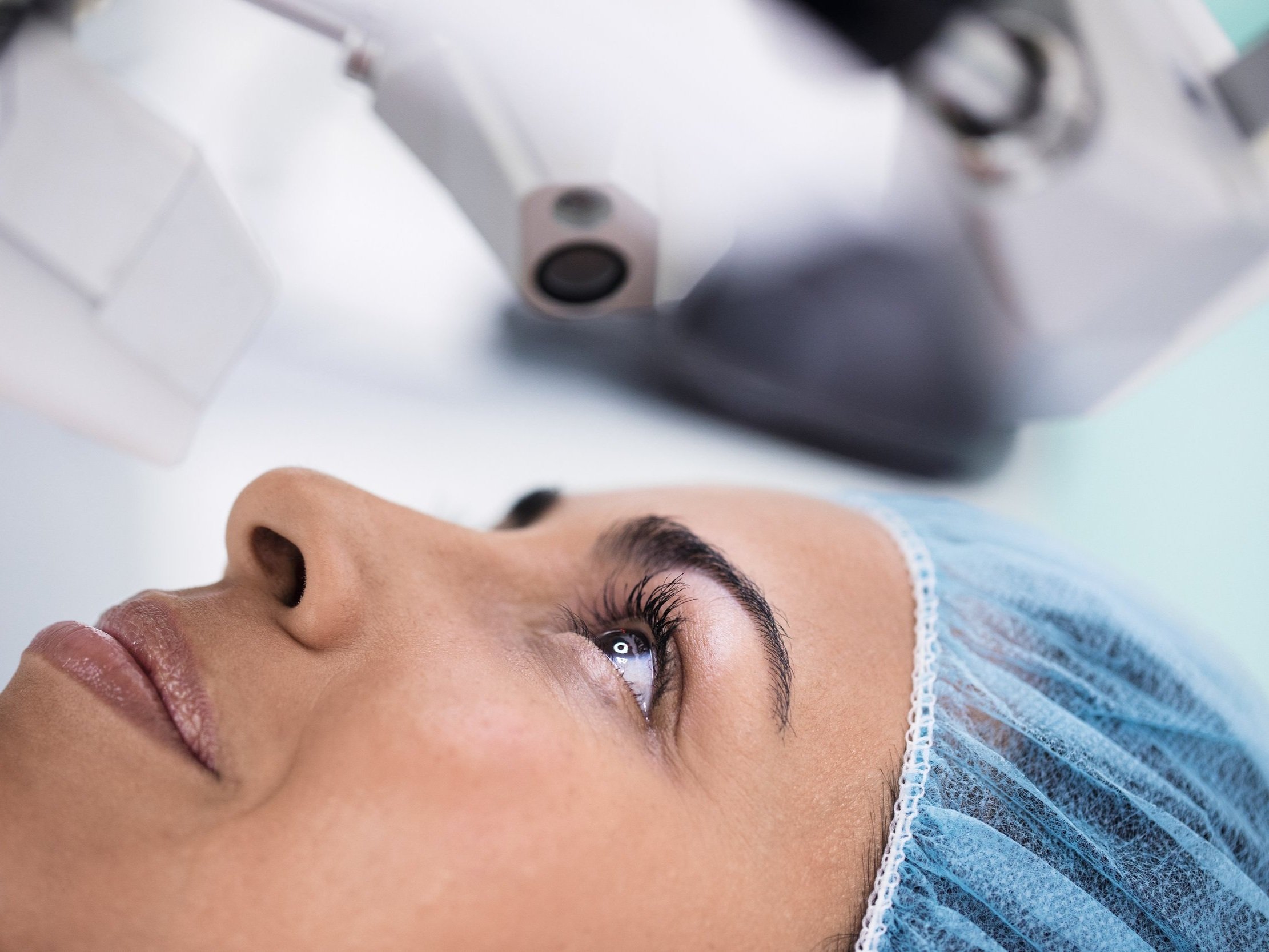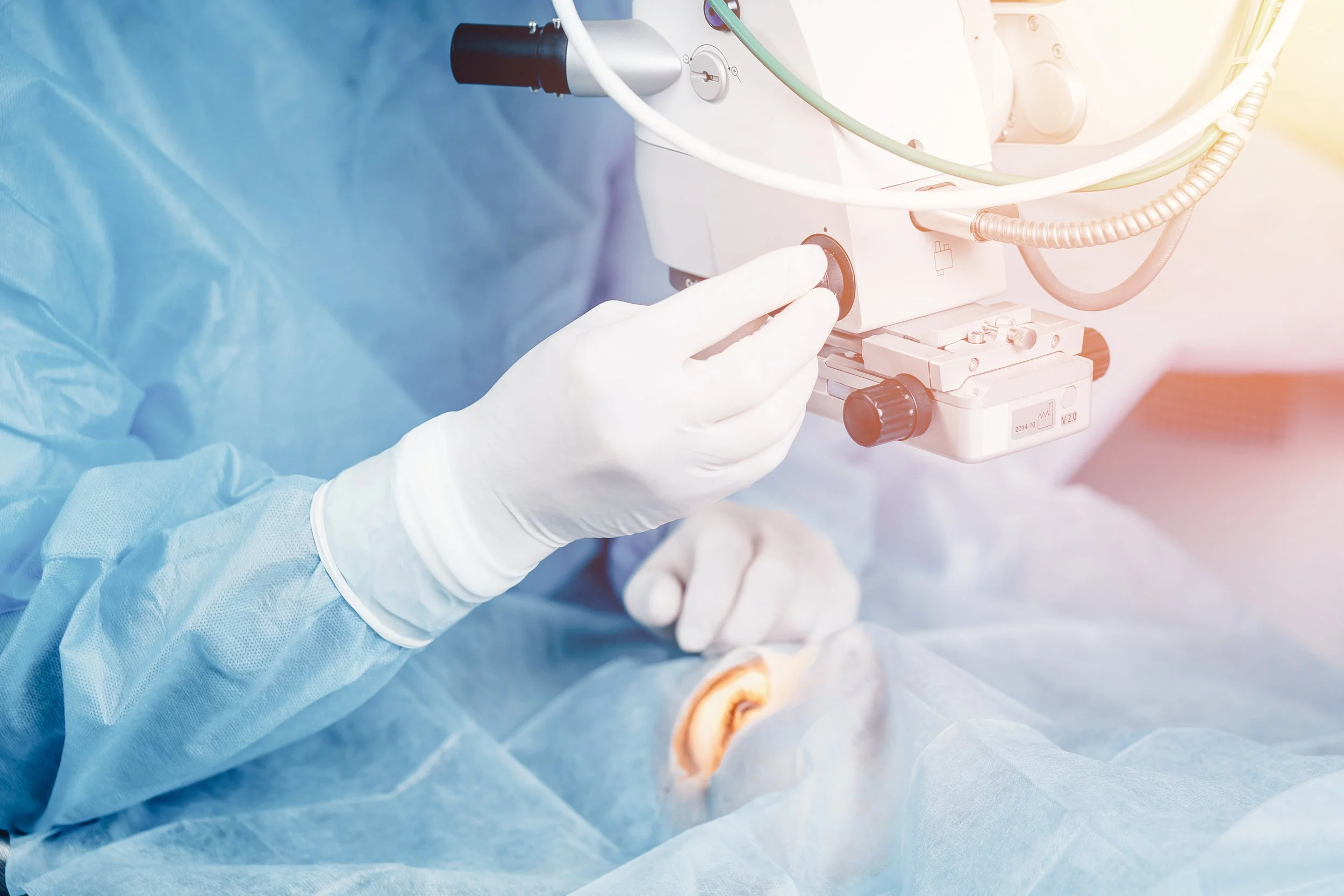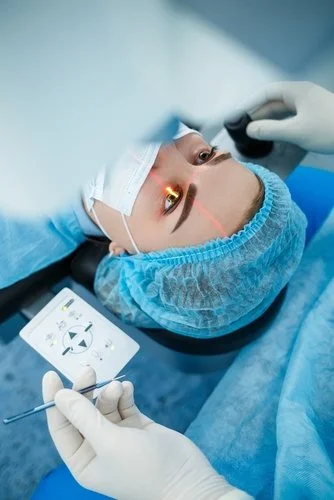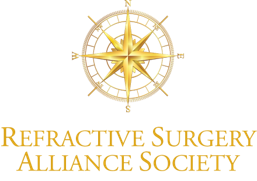A Premium Ophthalmology Practice in Johannesburg which specializes in Cataract Surgery, LASIK, Keratoconus and Glaucoma
Quality of Vision. Quality of Life.

Distinction in Vision Care
Our Eye Specialists can help you to experience the beauty of your world through Visual Freedom
-
![Cataract Surgery]()
Cataract Surgery
Advanced Refractive Cataract Surgery is tailored to your visual needs and aims to maximize spectacle independence
-
![LASIK]()
LASIK
Laser Vision Correction reshapes the cornea to correct near-sightedness, far-sightedness, astigmatism and presbyopia.
-
![Cross-linking]()
Cross-linking
A procedure which increases the biomechanical strength of the cornea to halt the progression of keratoconus
-
![Selective Laser Trabeculoplasty]()
Selective Laser Trabeculoplasty
An advanced treatment for open-angle glaucoma which can reduce or eliminate the need for eye drops.

-
![A smiling woman with curly black hair, wearing a beige top, standing against a plain white background.]()
“Thank you to Dr Bagus and Monica, my 5 year old daughter was actually excited to return to Constantia Eye Clinic and that says a lot. Would definitely recommend!”
Farenaaz
-
![Smiling young woman with long brown hair sitting on a sofa in a well-lit living room.]()
“What and incredible experience! From start to finish, Dr Bagus and Monica were kind, professional and friendly. Dr Bagus explained the process in such fine detail and made us feel comfortable through the entire process. I would personally recommend this practice to anyone needing eye procedures of any nature. Thank you Dr Bagus!”
Nicole
-
![Portrait of a smiling woman wearing a blazer and white shirt, standing outdoors with a modern building in the background.]()
“Lovely service, from the time you walk in. The Dr gives detailed and satisfactory check up and ensures that you're satisfied. All questions are answered accordingly . I am very happy with the hospitality and consultation. Keep up the amazing work @Constantia Eye Clinic!”
Neo
-
![Close-up outdoor portrait of a smiling man with a beige and brown sweater, with blurred trees and foliage in the background.]()
"Wonderful experience. Dr Hajee was patient caring and her knowledge exceptional. Thank you for helping me with my eye problem. All your patients will have the best care"
Christo
-
![An elderly African American woman and man smiling, standing close together in an indoor setting, with the man's arm around the woman's shoulder.]()
"Dr and receptionist were very professional and kind. We felt like staying longer at the Dr's room."
Jean
Transform Your Vision with LASIK at Constantia Eye Clinic

Experience the freedom of clear, glasses-free vision with LASIK, the world’s leading laser eye surgery. Our expert surgeons use cutting-edge technology to correct common vision problems such as nearsightedness, farsightedness and astigmatism. LASIK is a safe, quick and effective procedure tailored to your unique vision needs. Discover why thousands trust us for their LASIK journey and take the first step toward a clear future today.
See Your World Clearly Again with Cataract Surgery
Cataract Surgery with state-of-the-art technology and a tailored treatment plan ensures a seamless experience to restore your vision and maximize spectacle independence.
Living with diabetes comes with many health considerations—including eye health. One of the most common vision problems affecting diabetic patients is cataracts—a clouding of the eye’s natural lens that can cause blurred or dulled vision. While cataract surgery is highly effective in restoring clarity, diabetic patients require additional care and expertise to ensure optimal outcomes.
Cataract surgery is one of the most effective and commonly performed procedures in modern medicine, offering patients a chance to restore clear vision and significantly improve their quality of life. In South Africa’s private healthcare sector, however, many patients are understandably concerned about the cost. At Constantia Eye Clinic, we believe in transparency and informed decision-making. This guide outlines what to expect when budgeting for cataract surgery and the factors that influence the price.
Cataract surgery offers a once-in-a-lifetime chance to restore clear vision – and also the opportunity to reduce your dependence on glasses. One of the biggest decisions you’ll face when scheduling cataract surgery is choosing between a standard monofocal intraocular lens (IOL) or a premium IOL. Premium IOLs (which include multifocal, trifocal, extended depth-of-focus, and toric lenses) promise a broader range of vision, potentially freeing you from glasses for most tasks. But they also come at a higher out-of-pocket cost and are more susceptible to visual aberrations. So are premium IOLs worth it? Let’s break down the differences, backed by clinical research, to help you make an informed decision.
Femtosecond vs. Phaco Cataract Surgery Explained
When patients begin researching cataract surgery, a common question arises:
“Is laser cataract surgery better than traditional cataract surgery?”
With modern advances in eye care, the term “laser cataract surgery” has gained attention, but is it really necessary for excellent results? At Constantia Eye Clinic, we believe in offering safe, effective, and proven treatment options—so let’s break down the facts about femtosecond laser-assisted cataract surgery (FLACS) versus traditional phacoemulsification.
LASIK (Laser-Assisted In Situ Keratomileusis) has transformed the lives of millions by offering an effective solution to correct common vision problems such as near-sightedness, farsightedness and astigmatism. However, while LASIK is a highly successful procedure, it’s not the ideal choice for everyone. Determining whether you’re a good candidate for LASIK involves understanding several key factors—from your eye health and prescription to lifestyle considerations and overall expectations. In this article, we’ll walk you through the essential aspects to consider before deciding if LASIK is right for you.
Vision is one of our most vital senses, yet millions struggle with refractive errors that cloud our view of the world. Refractive surgery offers a solution by correcting these errors and restoring clarity. In this blog post, we’ll explore the science behind refractive surgery, detailing how it works and the technological innovations that make it possible.
If you’ve been struggling with glasses or contact lenses and are curious about vision correction, refractive surgery might be the answer. In this comprehensive guide, we’ll explore the world of refractive surgery with a particular focus on LASIK—one of the most popular and effective procedures available. We’ll also dive into other options like PRK and SMILE, helping you understand the differences, benefits and what to expect from these procedures.
Myopia, or nearsightedness, is one of the most common vision conditions, affecting people of all ages worldwide. Those with myopia can see nearby objects clearly, but distant objects appear blurry. Understanding what myopia is, how it impacts vision, and available corrective options can help individuals make informed decisions about managing this condition.
Myopia, or nearsightedness, has become increasingly common worldwide, particularly among children and young adults. Characterized by difficulty seeing distant objects clearly, myopia is caused by an elongation of the eyeball or a steepening of the cornea, which causes light to focus in front of the retina rather than directly on it. This visual impairment can progress over time, leading to higher degrees of myopia and a greater risk of complications, such as retinal detachment, glaucoma, and macular degeneration. To address this issue, myopia control has emerged as a critical approach to slow the progression of nearsightedness in children and adolescents. Here’s an in-depth look at the strategies for myopia control, lifestyle modifications, and age considerations.
Corneal cross-linking (CXL) is a groundbreaking treatment for keratoconus, a progressive eye condition that causes the cornea to thin and bulge into a cone-like shape. This procedure strengthens the cornea and helps prevent further distortion and vision loss. Since keratoconus can severely impact quality of life, cross-linking provides an essential treatment option, especially for patients diagnosed early. If you’re considering or have recently undergone corneal cross-linking, understanding the recovery process is key to ensuring optimal healing and visual improvement.
In this guide, we’ll explore the recovery timeline, essential aftercare tips, and factors to watch out for during healing. Whether you’re working closely with an ophthalmologist on your keratoconus management or just starting to research treatment, here’s what you need to know about recovery after corneal cross-linking.
LASIK (Laser-Assisted In Situ Keratomileusis) is a popular refractive surgery that offers the potential for clear, unaided vision. The procedure reshapes the cornea to correct common vision problems like myopia (nearsightedness), hyperopia (farsightedness), and astigmatism. While LASIK has a relatively quick recovery compared to other surgeries, proper aftercare is crucial to minimize discomfort and ensure optimal results. This guide covers the typical recovery timeline, essential post-procedure care steps, and tips for a smooth recovery after LASIK.
Cataract surgery is a transformative procedure that can significantly enhance vision and quality of life. As with any surgery, a well-informed approach to recovery is essential to avoid complications. Knowing what to expect in terms of recovery time and post-surgery care—including managing conditions like dry eye—can ensure that healing goes smoothly. Here’s a comprehensive look at the recovery timeline, tips for post-surgery care, and advice on handling dry eye symptoms that may arise after surgery.
A cataract is a clouding of the eye's natural lens, which sits behind the iris and pupil. The lens is typically clear, allowing light to pass through and focus on the retina, where it’s processed and transmitted to the brain as a visual image. However, when a cataract forms, the lens becomes progressively opaque, leading to blurred vision, light sensitivity, and other visual disturbances. Cataracts are a common eye condition, particularly in older adults, as the lens naturally changes over time. Here, we’ll explore what cataracts are, how they develop, and how they affect vision.
Clear vision depends on light rays properly focusing on the retina, the layer of tissue at the back of the eye that processes images. When the eye's shape doesn’t allow light to focus correctly, refractive errors occur, causing blurry vision. The most common refractive errors are myopia (nearsightedness), hyperopia (farsightedness), and astigmatism. Each has unique characteristics and treatments and understanding them can help you make informed decisions about eye health and vision correction options.
When considering vision correction, LASIK (Laser-Assisted In Situ Keratomileusis) and PRK (Photorefractive Keratectomy) are two of the most popular options. Both procedures can reduce or eliminate the need for glasses or contact lenses, but they differ in technique, recovery, and suitability for various eye conditions. This guide will help you understand the differences between LASIK and PRK to help you make an informed decision.
Cataracts are a common age-related condition that can gradually impair your vision, affecting your quality of life. While cataract surgery is a safe and effective treatment, knowing when is the right time to proceed with surgery can be a difficult decision. This article will explore the key deciding factors to help you determine when it’s time for cataract surgery and what you should consider before scheduling the procedure.
Cataracts are one of the leading causes of vision problems, especially as we age. Often developing gradually, cataracts can cause blurry vision, difficulty seeing at night, and even complete vision loss if left untreated. Early detection is key to preserving your eyesight and maintaining your quality of life. In this article, we’ll explore the common symptoms of cataracts and when it’s time to see your doctor.
Cataracts are a leading cause of vision loss, especially among older adults. As we age, the lens of the eye naturally becomes cloudy, leading to blurry vision, difficulty seeing at night and even blindness if left untreated. While cataracts are often associated with aging, there are several steps you can take to reduce your risk and protect your eye health. In this article we’ll explore whether cataracts can be prevented and share practical tips for maintaining healthy vision throughout your life.
Cataracts are one of the most common causes of vision impairment, particularly among older adults. Over time, the eye's natural lens becomes cloudy, which can lead to blurry vision, difficulty seeing at night, and even blindness if left untreated. There are different types of cataracts, and each type can affect your vision in distinct ways.
Visiting an ophthalmologist for the first time is a crucial step in maintaining your eye health. Whether you're dealing with vision issues or seeking routine care, knowing what to expect can ease any anxiety you may have. Here’s a detailed overview of what typically happens during your first visit to an ophthalmologist.
Taking care of your eyes is crucial to maintaining good vision and overall health. While routine eye exams are essential, there are specific situations where seeing an ophthalmologist—a medical doctor specializing in eye and vision care—is particularly important. Whether you're experiencing new symptoms, managing an existing condition or seeking preventive care, here are the top reasons to make an appointment with an ophthalmologist.
When it comes to your eye health selecting the right ophthalmologist is crucial. Whether you need a routine eye exam, treatment for a specific condition or specialized surgery, having a qualified and experienced eye care professional is essential. With so many options available, how do you choose the right ophthalmologist for your needs? This guide will walk you through the key factors to consider, ensuring you make an informed decision that best suits your eye care requirements.
Corneal cross-linking is a minimally invasive procedure designed to strengthen the cornea by creating new bonds between the collagen fibres within it. This process helps to halt the progression of keratoconus and reduce the risk of further vision loss.
Discover everything you need to know about LASIK, a revolutionary laser eye surgery that corrects vision problems like nearsightedness, farsightedness, and astigmatism. Learn about the procedure, benefits, risks, and if you're a suitable candidate for this life-changing treatment.
Learn about the different types of intraocular lenses (IOLs) used in cataract surgery, including monofocal, multifocal, toric and EDOF IOLs. Discover which lens is best for your vision needs.
Discover how cataract surgery is performed, from initial consultation to recovery. Learn about the procedure, types of intraocular lenses, and what to expect before, during and after surgery.
Learn about Selective Laser Trabeculoplasty (SLT), a non-invasive and effective treatment for glaucoma that can reduce intraocular pressure and dependence on medications.
Discover how Optical Coherence Tomography (OCT) and Perimetry are revolutionizing glaucoma diagnosis. Learn about their benefits, how they work, and why they are essential for early detection and effective management of glaucoma.
Understanding eye health is crucial for maintaining good vision and overall well-being. When it comes to eye care, one specialist stands out: the ophthalmologist. But what exactly is an ophthalmologist, and how do they differ from other eye care professionals? In this guide we'll explore the role of an ophthalmologist, their training, the conditions they treat and why regular visits are essential for your eye health.
Learn about glaucoma symptoms, causes, treatment options and prevention methods. Stay informed and protect your vision with our comprehensive guide.













































